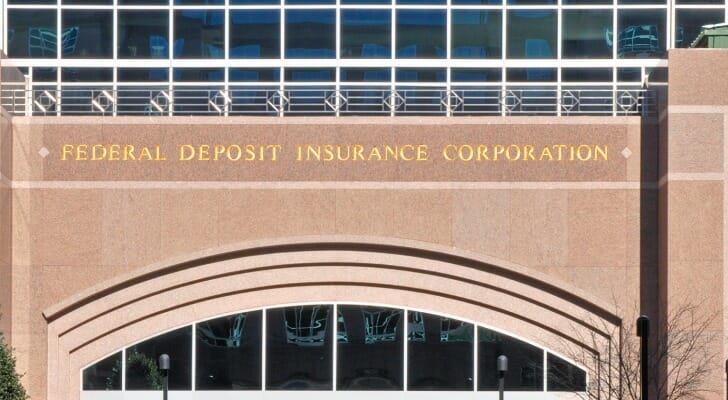If you have ever listened to the radio or watched television, chances are you have heard a commercial for a bank talking about being FDIC-insured. FDIC stands for Federal Deposit Insurance Corporation, and it is the federal agency that insures the money that Americans put into their commercial bank accounts. However, you may still wonder just how much FDIC insurance covers in the event of a bank collapse or other serious problems with the financial system. This is what you need to know about how FDIC insurance works and how much it covers.
If you want to maximize your savings, a financial advisor can help you put together a financial plan.
What Is FDIC Insurance?
The Federal Deposit Insurance Corporation (FDIC) is an independent federal agency that is responsible for safeguarding citizen deposits in the event that a bank fails in the United States.
The agency insures a certain amount of deposits for every bank account that is opened by banks that it qualifies. The maximum amount insured of any account by the FDIC is $250,000. It also gives you up to $250,000 per account in the event that the bank can’t meet the demand of its customers.
FDIC insurance is important because it provides the peace of mind that your money is insured with your banking institution. This prevents you from having to buy other insurance to protect your bank assets and allows your money to be kept in a safe place.
What Does FDIC Insurance Cover?

As stated above, the general rule is that the FDIC covers $250,000 per depositor, per FDIC-insured bank, and per ownership category. This applies to both principal, which is the money that you have deposited in your account and any money that you’ve earned as interest since depositing your money.
It’s important to note that not all accounts at a bank are eligible for FDIC insurance. Covered products include:
The FDIC covers $250,000 per depositor, per FDIC-insured bank and per ownership category. This applies to both principal, which is the money that you have deposited in your account and any money that you have earned as interest since depositing your money.
It is important to note that not all accounts at a bank are eligible for insurance. Before you open an account, check this chart to see if it is covered by the FDIC.
| Covered by the FDIC | Not Covered by the FDIC |
|---|---|
| Checking accounts | Stocks |
| Negotiable order of withdrawal (NOW) accounts | Bonds |
| Savings accounts | Mutual funds |
| Money market deposit accounts | Life insurance policies |
| Time deposits (e.g., certificates of deposit) | Annuities |
| Cashier’s checks and money orders | Municipal securities |
| Safe deposit boxes or their contents | |
| U.S. Treasury bills, notes, or bonds (backed by the U.S. government, but not by FDIC) |
You may get non-covered products through a bank or financial institution that advertises some of its products as FDIC-insured. Be sure to check with someone at the bank before you buy a product so you can confirm whether it is FDIC-insured.
Are There Ways to Maximize FDIC Insurance Coverage?

There are two basic ways to maximize your FDIC insurance. The first is to open accounts at different banks. You could have one account with up to $250,000 at Citi and another with up to $250,000 at Bank of America. The FDIC will insure both of these accounts.
It’s important to note, though, that different branches of the same bank are considered one bank. Thus, you can’t open one Bank of America account in Cleveland and one in New York and expect the FDIC to insure both.
The other way to maximize FDIC insurance is to have accounts at the same bank in different ownership categories. You get up to $250,000 in coverage for each ownership category, even within the same bank. The ownership categories recognized by the FDIC are:
- Single accounts: Any account owned by one person only, including checking accounts, savings accounts, money market deposit accounts and CDs. This also includes business accounts in which one person is the sole proprietor.
- Certain retirement accounts: Covered retirement accounts include traditional IRAs, Roth IRAs, SIMPLE IRAs, SEP IRAs, self-directed 401(k)s, profit-sharing plans, self-directed Keogh plans and section 457 deferred compensation plans.
- Joint accounts: These are opened by multiple people, including spouses. The FDIC insures $250,000 per person in joint accounts (for a total of $500,000) and divides money equally among owners for this purpose.
- Revocable trust accounts: A deposit account that identifies one or more people as beneficiaries who will get the contents of the account when the owner dies.
- Irrevocable trust accounts: This is a deposit account established by a statute or written trust agreement in which the owner cedes power to change or cancel the trust.
- Employee benefit accounts: Deposits of a pension plan or other defined benefit plan that is not self-directed.
- Corporation, partnership, or unincorporated association accounts: Deposits owned by corporations, partnerships and unincorporated associations. This includes both for-profit and not-for-profit organizations.
- Government accounts: Deposits owned by federal, state or local government, or an Indian tribe.
Married couples will have another option for maximizing their FDIC insurance coverage. You and your spouse each can open individual accounts at a single bank, resulting in each of you having up to $250,000 FDIC-insured. You can then also open a joint account and each has $250,000 insured in that account. Between those three accounts, you could have up to $1 million FDIC-insured at one bank.
What Assets Should You Put in FDIC-Protected Accounts?
You should use FDIC-insured accounts for any money that you want to protect. For many, this will mean any money that you have not invested in the stock market. If you are willing to risk losing money, you’d be better served to invest that money in stocks or bonds. Though these also carry risks, you’ll at least also have the potential to make returns.
If you’re saving money for a rainy day fund, though, put it in an FDIC-protected account. Otherwise, you could end up losing the nest egg you thought you had, should something bad happen to the institution you are using.
How to Contact the FDIC
You can reach the FDIC in several ways:
- Call toll-free: 877-275-3342
- For the hearing impaired call toll-free: 800-925-4618
- Online: https://ask.fdic.gov/fdicinformationandsupportcenter/s/?language=en_USRead
Frequently Asked Questions (FAQs)
How Much Does FDIC Cover on a Joint Account?
FDIC insurance protects your funds up to $250,000 per depositor, per FDIC-insured bank and per ownership category. Because there are two people on the account, it is insured up to $500,000 to account for both parties.
What Should You Do If You Have Over the FDIC Limit at a Bank?
If you are over the FDIC limit at a bank, you have a few options. You can open a new type of account with the same bank, such as a checking account and IRA. You can also opt to open a new account with a new bank to help ensure protection for your funds.
Does the FDIC Cover Multiple Accounts at One Bank?
The FDIC covers different types of accounts at one bank. They cannot be in the same ownership category. For example, while an individual checking and savings account will not give you dual protection, you could open a single checking account and joint checking account at the same bank to receive protection for both, up to $500,000.
Bottom Line
FDIC insurance covers up to $250,000 per depositor for each ownership category in each distinct bank. You can open accounts at different banks or in different ownership categories at one bank to maximize your insurance coverage. Use FDIC-insured accounts for any money that you want to protect against potential market shakeups or bank closures.
Tips for Protecting Your Assets
- If you’re starting to think seriously about how to maximize your financial efficiency, you should consider working with a financial advisor. Finding the right financial advisor that fits your needs doesn’t have to be hard. SmartAsset’s free tool matches you with vetted financial advisors who serve your area, and you can have a free introductory call with your advisor matches to decide which one you feel is right for you. If you’re ready to find an advisor who can help you achieve your financial goals, get started now.
- One type of FDIC-insured account is a certificate of deposit. Check out our list of the best CD rates in the country. Though not the most high-reward option, CD accounts are low risk.
Photo Credit: ©iStock.com/tinabelle, ©iStock.com/AndreyPopov, ©iStock.com/hsyncoban
